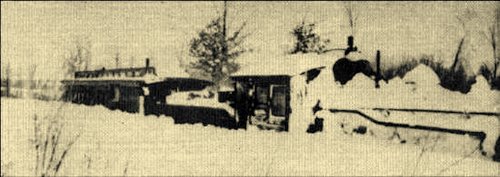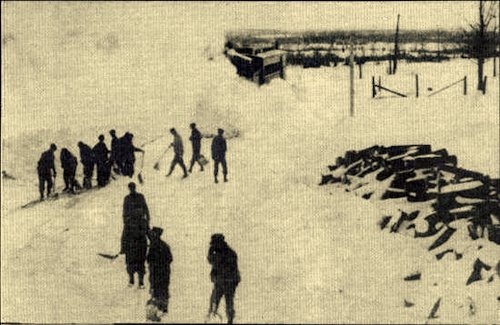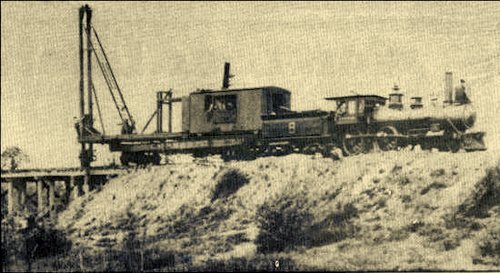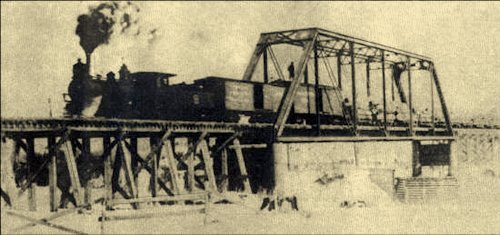|
|
 |
Clark County Press, Neillsville, WI March 8, 1995, Page 28 Transcribed by Dolores (Mohr) Kenyon. Index of "Oldies" Articles
|
|
|
 |
Clark County Press, Neillsville, WI March 8, 1995, Page 28 Transcribed by Dolores (Mohr) Kenyon. Index of "Oldies" Articles
|
Good Old Days
By Dee Zimmerman
As we received snow falls within the past few days, we were reminded of the inconveniences snow can create when we have to travel. The present day snow removal equipment and operators quickly have the roads in good driving condition soon after the snowfall stops.
Such service was not available years ago, before the motorized snow removal machines era. There was a time when the snow became too deep your only means of travel was to ski or snowshoe over the top. It was difficult for horses to make a long trek through very deep snow, too.
The early railroads also found large snowfalls to be a detriment in their progress of operation. The firm of Foster, Cook and Company constructed a tramway north of Fairchild in 1878. Within three years, the operations of this company had expanded to the point that it had the most extensive tramways for bringing in logs of any concern in western Wisconsin.
The timberland in western Clark County owned by Foster Lumber Company was not adjacent to waterways suitable for the floating of logs to the Fairchild mill pond. Thus, as crews and camps got farther away from the mill, the matter of efficient transportation of logs to the mill pond became a concern.
The solution to the problem was solved by the Foster railroads when the first tram3way was a road that used cars with concave wheels which were pulled by horses over wooden rails made from timber along the right-of-way. Foster was considered the innovator of the concept of using railroads for logging operations in the state. By 1885, there were four other tramways in existence in the state.
Expansion of logging operations led to extension of the railroad. There was a gradual growth of the foster railroad. The passenger service was a sideline made available to that area by N. C. Foster. The primary purpose of the railroad was in transporting logs in the early years, never recorded passenger fees. By the late 1890s, the county’s west central area had been logged out, the big timber was gone, all been harvested.
As time went on, Clark County’s development in agriculture brought about a reorganization of the Foster and N.E. line which was to serve Greenwood, a lumbering and agriculture community. The 23 miles of track from Fairchild to Greenwood was completed in 1898. By 1900, construction of extending that line to Coxie and Bright stations, beyond Greenwood, was done. By 1909, the end of the line to Owen, finalized that railway expansion. Agricultural products were then the largest shipping business for the Foster Co.’s enterprise. It was in 1907 when the line started providing general service which included the passenger service.
The N. C. Foster Railway and enterprise had a unique history, one of its kind.

|
Snowbound! Stuck in the snow one and one-half miles north and one and one-half miles east of Willard where there were some deep cuts. The Owega station was just east of this scene. It was a section of railway owned and operated by the N. C. Foster Enterprise. |

|
The winter of 1924: at the Tioga crossing three and one-half miles south and three and one-half miles west of Willard. Hand shoveling of snow was a common practice on the F & N.E. during winter months. Shovels and the locomotive pilot were the removal equipment. At this particular time, it looks as though some Tioga area residents came to help with the shoveling. |

|
The F&N.E. Railroad crossed a bridge on Thompson Creek, a mile south of Tioga. J. Foster Adams took this picture of the rented Omaha pile driver as the F&N.E. bridge was being repaired, June, 1905. |

|
The F&N.E. Bridge, a mile west of Greenwood, was built in 1898 for $50,000. This 1903 photo, in its winter scene, shows a couple boxcars, followed by flatbeds of logs, on the way to Fairchild. The bridge was dismantled in 1934. |
When choosing between two evils, I always like to try the one I’ve never tried before. – Mae West
¤¤¤¤¤¤¤¤¤¤¤¤¤¤¤
Weed – a plant whose virtues have not yet been discovered. – Ralph Waldo Emerson
|
© Every submission is protected by the Digital Millennium Copyright Act of 1998.
Show your appreciation of this freely provided information by not copying it to any other site without our permission.
Become a Clark County History Buff
|
|
A site created and
maintained by the Clark County History Buffs
Webmasters: Leon Konieczny, Tanya Paschke, Janet & Stan Schwarze, James W. Sternitzky,
|